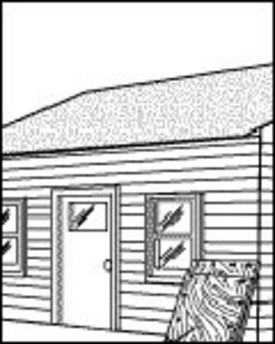 |
What You Can Do
Hurricane and tornado protection can involve a variety of changes to your house and property — changes that can vary in complexity and cost. You may be able to make some types of changes your-self. But complicated or large-scale changes and those that affect the structure of your house or its electrical wiring and plumbing should be carried out only by a professional contractor licensed to work in your state, county, or city. One example of hurricane protection, illustrated below, is installing storm shutters or temporary plywood covers to protect windows. These are things that skilled homeowners can probably do on their own.
Install Shutters or Plywood Window Covers
High winds and windblown debris can easily break unprotected windows and then enter your house. Once inside, wind and debris can cause more damage. Protecting windows not only helps you avoid damage to your house, it also reduces the likelihood that you or members of your family will be hurt by broken glass and debris.
Windows can be protected with permanent storm shutters or, as shown in the figure, temporary plywood covers. Permanent storm shutters can usually be closed quickly and easily — an advantage over temporary covers. But temporary covers can be an economical alternative and can be installed fairly quickly if the necessary preparations are made. Plywood covers can also be used to protect sliding glass doors and French doors.
Tips
Keep these points in mind when you install shutters or use temporary plywood covers:
- You should always consider using permanent storm shutters if you live in an area where you know you will need to act quickly to protect your windows.
- If you decide to use temporary plywood covers, you may want to hire a contractor or handyman to make them for you. If you do the work yourself, you will need to cut the plywood and drill holes for screws or lag bolts in each cover and in the wall around each window. The screws or lag bolts should be placed along the top, bottom, and sides of each cover, and they should be long enough to penetrate the wall studs around the window, not just the siding or wall covering.
- Don’t wait until a hurricane warning is issued to make the covers; you probably won’t have time. Make them now so that you’ll be ready to install them quickly. Store the mounting screws or lag bolts with the covers, in a place where they are readily accessible — don’t stack heavy boxes or other hard-to-move materials on top of or around the covers. Use a numbering or lettering system that shows which cover goes with which window.
Estimated Cost
Storm shutters can cost $50 to $60 per square foot of window. So a set of shutters for a 3-foot by 4-foot window could cost about $600 to $720. The cost of a plywood cover will also depend on the size of the window. If you do the work yourself, you can expect plywood to cost about $0.60 per square foot. Screws or lag bolts, including washers, will cost about $0.10 to $0.15 each. So, for example, protecting a window that is 3 feet wide and 4 feet high will cost you about $10. This figure covers only the materials you will have to buy and excludes the cost of any tools you use and the value of your time. If you hire a contractor or handyman to do the work, you will have to pay for time as well as materials.




























